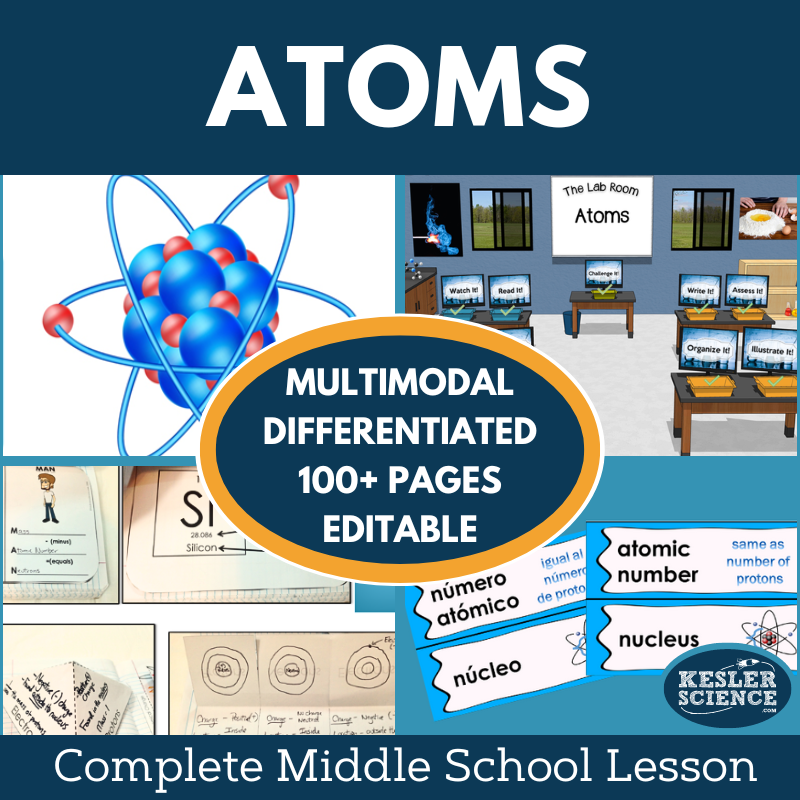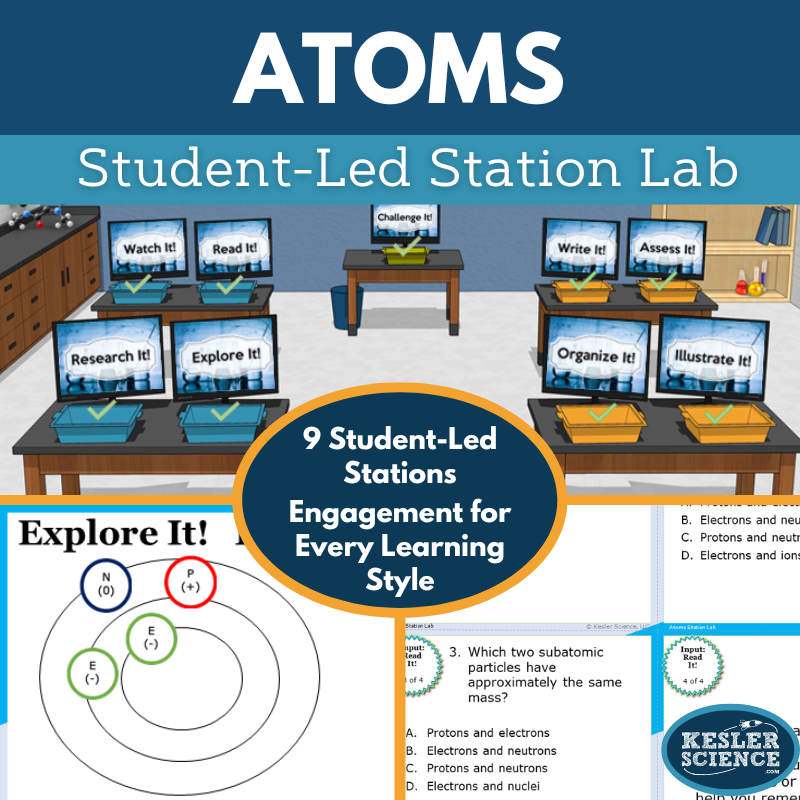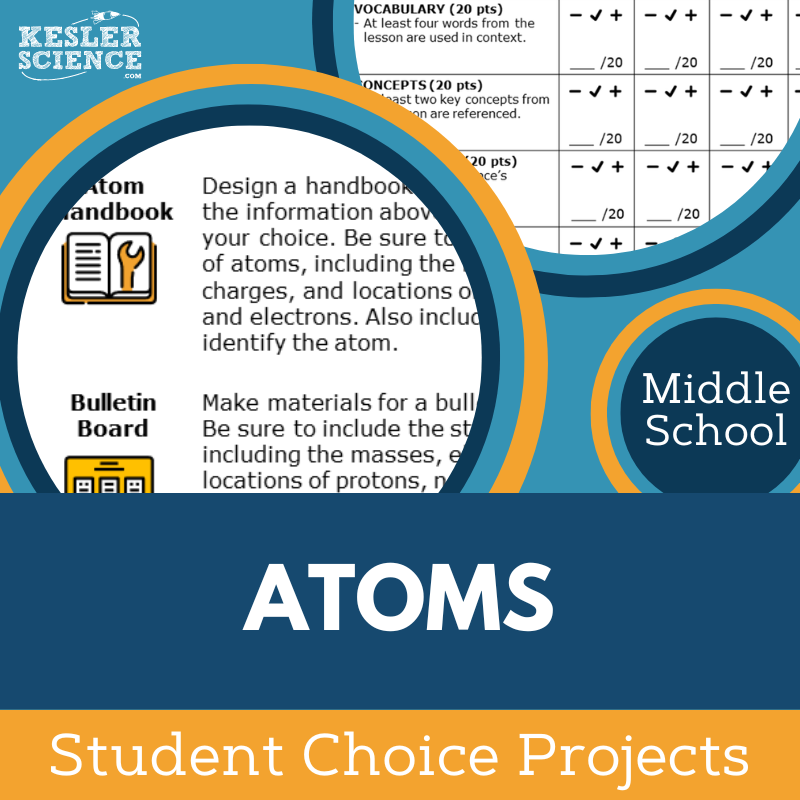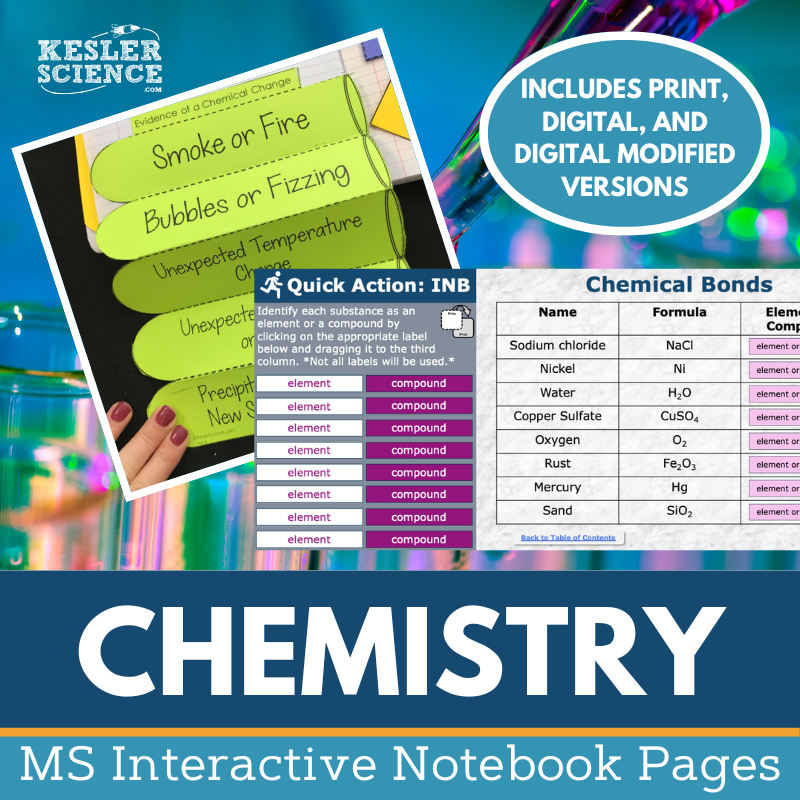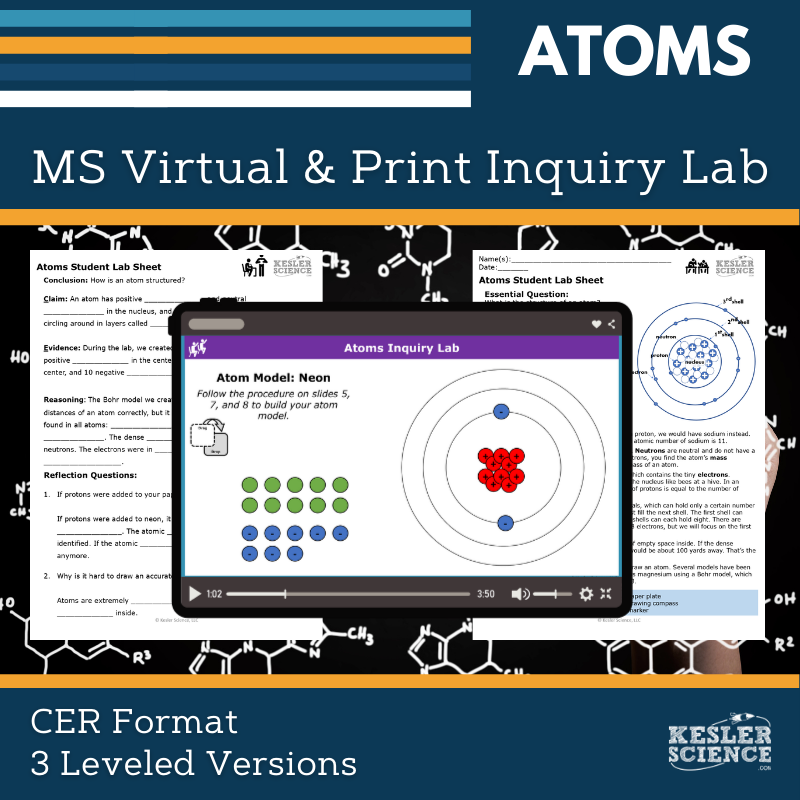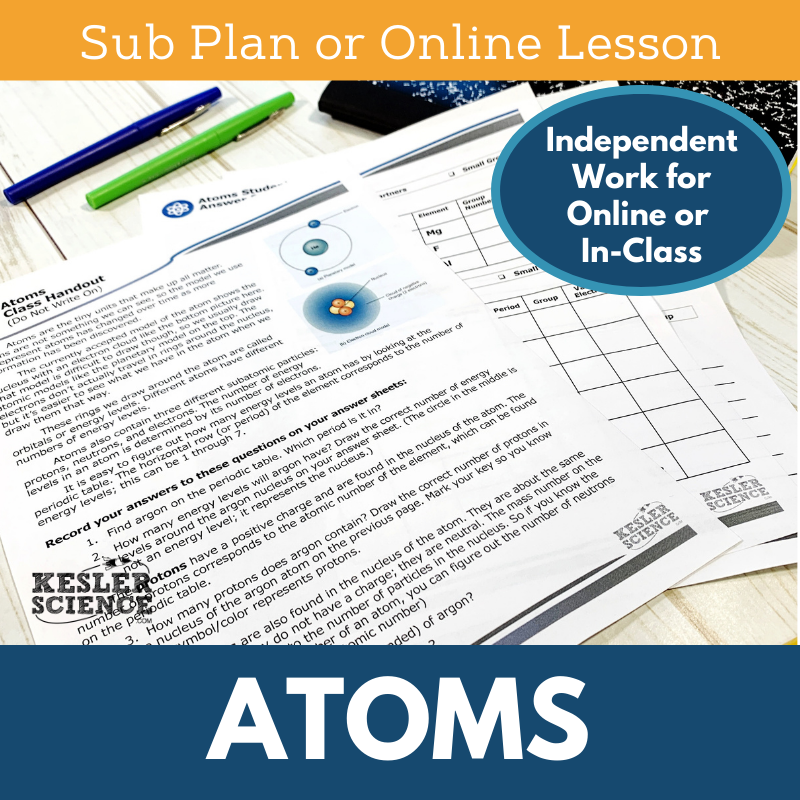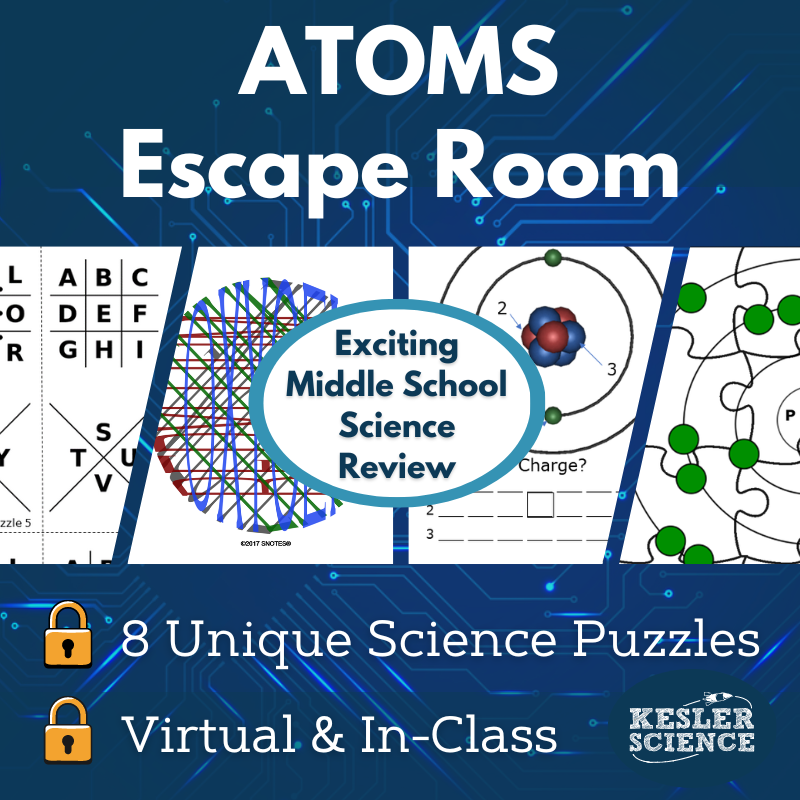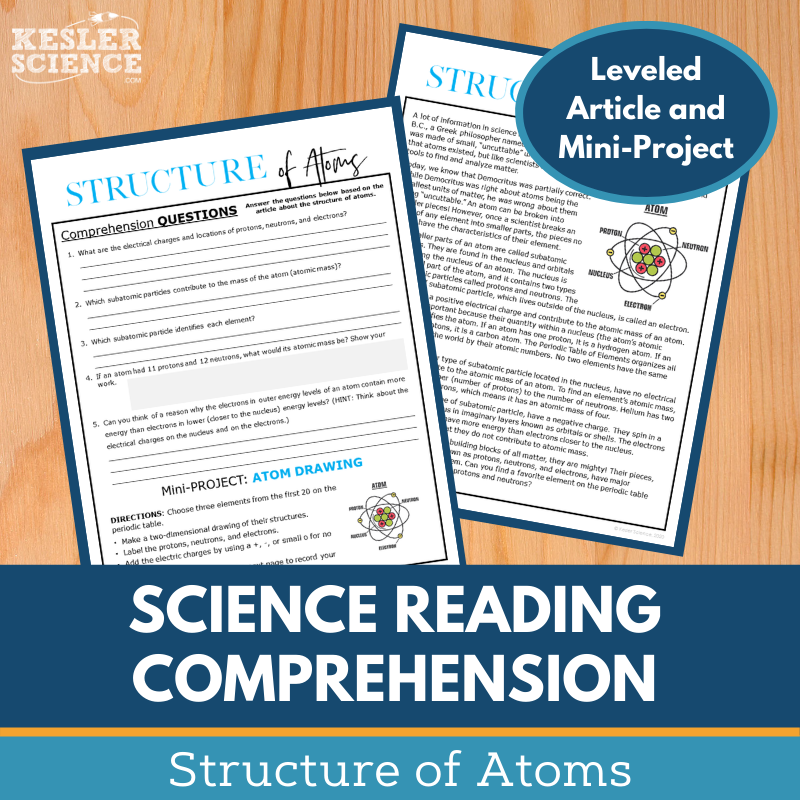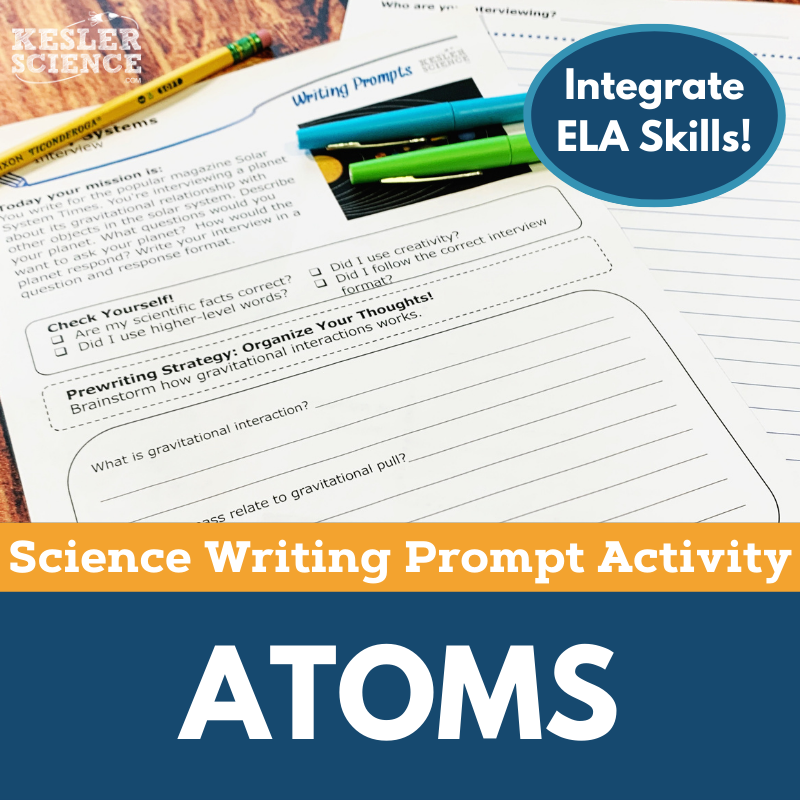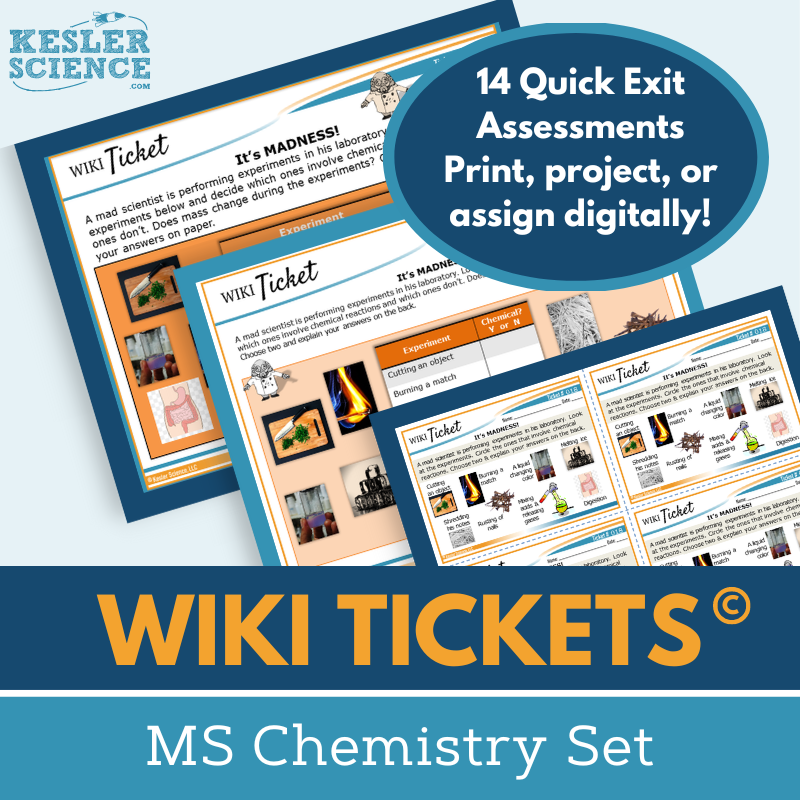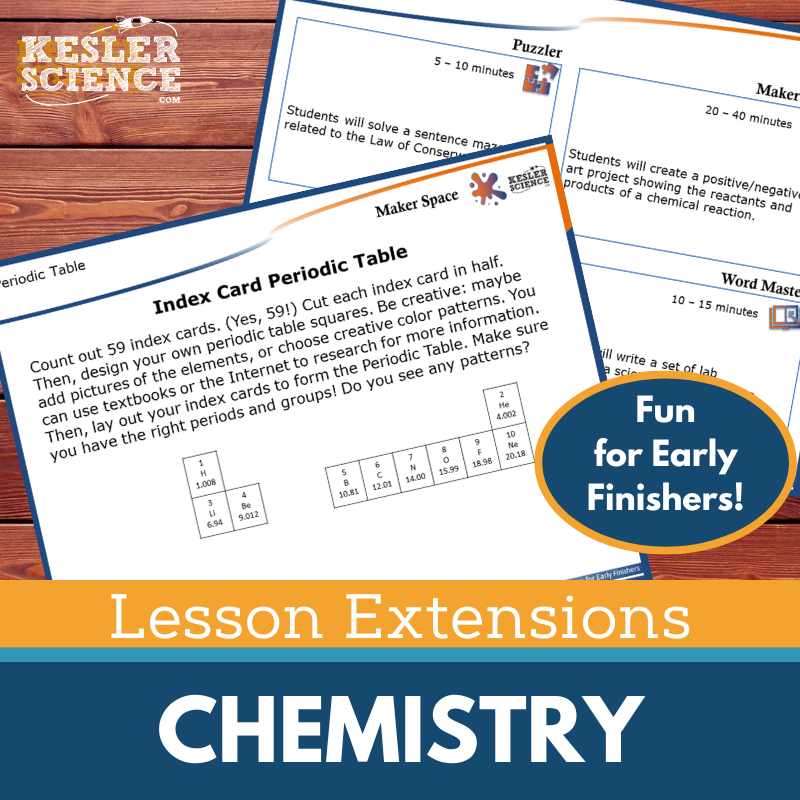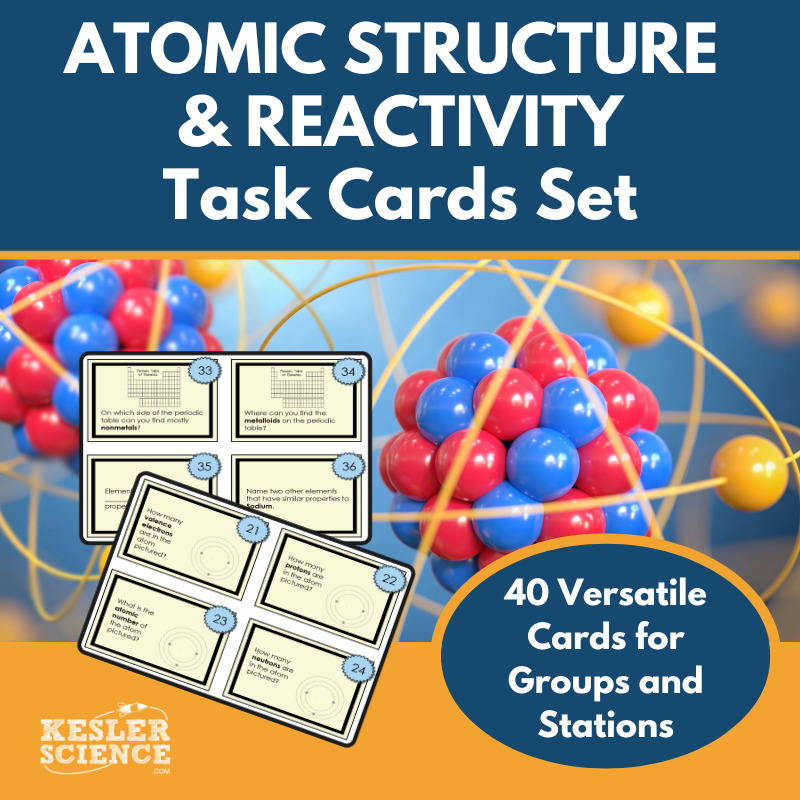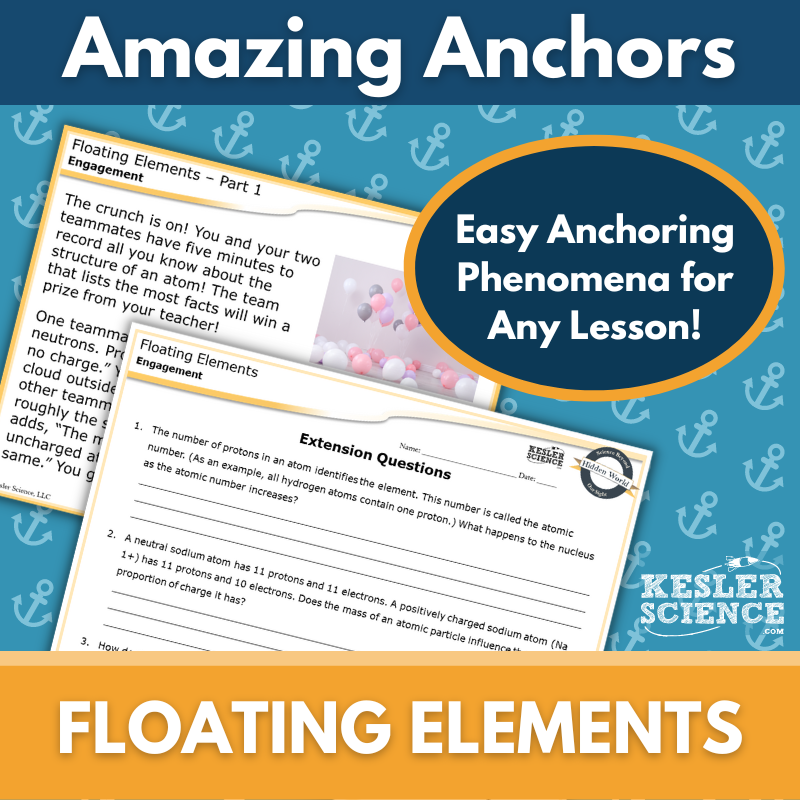Atoms Activities for Middle School Science
Kesler Science Atoms resources provide a comprehensive, student-centered approach to teaching middle school students about atomic structure, subatomic particles, and their properties. The resources below will give students a comprehensive understanding of atoms. All of the following materials are also included in the Kesler Science Membership.
The Kesler Science Atoms Complete 5E Lesson provides everything you need to teach a comprehensive, engaging, multi-day unit on atoms with minimal prep. The lesson is designed for student-led learning, focusing on essential questions such as the structure of atoms, the calculation of atomic mass, and the role of protons in determining an atom’s identity.
The lesson follows the 5E Model, with engaging activities in each phase: Exploration through differentiated stations, including hands-on demos, reading, research, and videos; Explanation through editable PowerPoints, interactive notebooks, and note-taking templates; and Evaluation with assessment questions and review activities.
With flexible formats for in-person or virtual learning, differentiated materials, and Spanish translations, this lesson is ideal for addressing diverse learning needs while making your lesson planning easier.
The Kesler Science Atoms Complete 5E Lesson provides everything you need to teach a comprehensive, engaging, multi-day unit on atoms with minimal prep. The lesson is designed for student-led learning, focusing on essential questions such as the structure of atoms, the calculation of atomic mass, and the role of protons in determining an atom’s identity.
The lesson follows the 5E Model, with engaging activities in each phase: Exploration through differentiated stations, including hands-on demos, reading, research, and videos; Explanation through editable PowerPoints, interactive notebooks, and note-taking templates; and Evaluation with assessment questions and review activities.
With flexible formats for in-person or virtual learning, differentiated materials, and Spanish translations, this lesson is ideal for addressing diverse learning needs while making your lesson planning easier.
The Kesler Science Atoms Station Lab is a student-led, modular activity designed to engage middle school students in learning about atoms. It offers a range of differentiated activities that allow students to explore the structure of atoms and understand that protons determine an element's identity. With nine stations, students work independently or in small groups, facilitating their own learning experience.
The stations cover input and output activities, including hands-on demonstrations, reading, research, and videos. There are also opportunities for students to organize, illustrate, and write about atoms, while advanced learners can enjoy a bonus challenge station with games and mini-projects.
This resource can be used in both physical and virtual classrooms, providing a flexible learning experience for all students. It’s perfect for helping middle school students deepen their understanding of atomic structure while saving teachers prep time.
The Kesler Science Atoms Station Lab is a student-led, modular activity designed to engage middle school students in learning about atoms. It offers a range of differentiated activities that allow students to explore the structure of atoms and understand that protons determine an element's identity. With nine stations, students work independently or in small groups, facilitating their own learning experience.
The stations cover input and output activities, including hands-on demonstrations, reading, research, and videos. There are also opportunities for students to organize, illustrate, and write about atoms, while advanced learners can enjoy a bonus challenge station with games and mini-projects.
This resource can be used in both physical and virtual classrooms, providing a flexible learning experience for all students. It’s perfect for helping middle school students deepen their understanding of atomic structure while saving teachers prep time.
The Kesler Science Atoms Student Choice Projects offer middle school students a range of project options to demonstrate their understanding of atoms. Students can choose from six project choices or create their own, with the flexibility to work in different formats. A grading rubric allows assessments by teachers, peers, or the students themselves, making it adaptable for various learning styles.
The lesson includes nine project options and a "design your own" project, with teacher directions and an editable rubric. It is differentiated to accommodate students needing more support or challenges.
This project uses simple classroom supplies like paper, markers, and scissors, though many projects can be completed digitally. It provides a creative, student-centered way to show mastery of the topic.
The Kesler Science Atoms Student Choice Projects offer middle school students a range of project options to demonstrate their understanding of atoms. Students can choose from six project choices or create their own, with the flexibility to work in different formats. A grading rubric allows assessments by teachers, peers, or the students themselves, making it adaptable for various learning styles.
The lesson includes nine project options and a "design your own" project, with teacher directions and an editable rubric. It is differentiated to accommodate students needing more support or challenges.
This project uses simple classroom supplies like paper, markers, and scissors, though many projects can be completed digitally. It provides a creative, student-centered way to show mastery of the topic.
The Kesler Science Chemistry Interactive Notebook Bundle provides an engaging way for students to explore chemistry concepts through interactive activities. Designed for both traditional classrooms and digital learning environments, this bundle includes print and digital versions, making it versatile for in-person, 1:1, or distance learning settings.
Topics covered include acids and bases, atoms, balancing chemical equations, chemical bonds, physical and chemical changes, the periodic table, properties of water, and more. The digital version features a unique PowerPoint interactive notebook that can be uploaded to platforms like Google Slides, MS Teams, or Schoology. It includes reflection pages, note-taking space, a teacher answer key, and a modified version for students needing accommodations.
The paper version offers blank templates for student interaction, pre-filled options for modified learners or absentees, and visual examples for guidance. This resource is ideal for fostering hands-on and digital engagement in middle school chemistry.
The Kesler Science Chemistry Interactive Notebook Bundle provides an engaging way for students to explore chemistry concepts through interactive activities. Designed for both traditional classrooms and digital learning environments, this bundle includes print and digital versions, making it versatile for in-person, 1:1, or distance learning settings.
Topics covered include acids and bases, atoms, balancing chemical equations, chemical bonds, physical and chemical changes, the periodic table, properties of water, and more. The digital version features a unique PowerPoint interactive notebook that can be uploaded to platforms like Google Slides, MS Teams, or Schoology. It includes reflection pages, note-taking space, a teacher answer key, and a modified version for students needing accommodations.
The paper version offers blank templates for student interaction, pre-filled options for modified learners or absentees, and visual examples for guidance. This resource is ideal for fostering hands-on and digital engagement in middle school chemistry.
The Atoms Inquiry Lab engages students in building a model of an atom based on the Bohr model. Students can participate using either a hands-on printed version or a fully digital interactive version. Both formats include comprehension questions, Claim-Evidence-Reasoning (C.E.R.) prompts, and a reflection section to reinforce understanding of atomic structure.
To support a wide range of learners, the lab includes three differentiated versions: a structured version for students needing more support, a modified version with simplified instructions and scaffolds, and an independent version that encourages student-led inquiry. All formats are editable and compatible with Google Slides for easy classroom integration.
In the print version, students will use materials like paper plates, silver and gold brads, and drawing compasses to create their atom models. The digital version requires no materials and includes interactive activities that allow students to explore atom structure virtually. Teacher resources, answer keys, and editable files are included to streamline planning and instruction.
The Atoms Inquiry Lab engages students in building a model of an atom based on the Bohr model. Students can participate using either a hands-on printed version or a fully digital interactive version. Both formats include comprehension questions, Claim-Evidence-Reasoning (C.E.R.) prompts, and a reflection section to reinforce understanding of atomic structure.
To support a wide range of learners, the lab includes three differentiated versions: a structured version for students needing more support, a modified version with simplified instructions and scaffolds, and an independent version that encourages student-led inquiry. All formats are editable and compatible with Google Slides for easy classroom integration.
In the print version, students will use materials like paper plates, silver and gold brads, and drawing compasses to create their atom models. The digital version requires no materials and includes interactive activities that allow students to explore atom structure virtually. Teacher resources, answer keys, and editable files are included to streamline planning and instruction.
In the Kesler Science Atoms Sub Plans, students begin with a warm-up puzzle, then read a passage to learn about atomic characteristics. They complete an activity where they build their own atoms, and early finishers can explore valence electrons and their relation to the periodic table. The lesson ends with an assessment or exit ticket.
This lesson includes substitute directions, answer keys, and student instructions. It also offers extension activities for early finishers and a summative assessment. For distance learning, the lesson includes a student PDF and Google Form answer sheet for easy virtual use.
The lesson is designed to be student-centered, with engaging activities and ample support for substitutes. It can be used for substitute plans, small group work, or as an at-home or extra credit assignment. The materials are flexible and editable for various learning environments.
In the Kesler Science Atoms Sub Plans, students begin with a warm-up puzzle, then read a passage to learn about atomic characteristics. They complete an activity where they build their own atoms, and early finishers can explore valence electrons and their relation to the periodic table. The lesson ends with an assessment or exit ticket.
This lesson includes substitute directions, answer keys, and student instructions. It also offers extension activities for early finishers and a summative assessment. For distance learning, the lesson includes a student PDF and Google Form answer sheet for easy virtual use.
The lesson is designed to be student-centered, with engaging activities and ample support for substitutes. It can be used for substitute plans, small group work, or as an at-home or extra credit assignment. The materials are flexible and editable for various learning environments.
The Kesler Science Atoms Escape Room provides an exciting and immersive way for students to showcase their knowledge about atoms. With eight independent puzzles, teachers have full control over which to use and in what order, making it adaptable for various class lengths. This highly engaging activity, complete with a mood-setting video introduction, will leave students buzzing about the experience for weeks.
The resource includes all necessary components, such as printable props, editable teacher materials, digital versions for Google Slides, and a detailed answer key. It also features bonus elements like reward templates, photo props, and a list of prize ideas to celebrate student success. The escape room can be conducted in class with simple materials like manila envelopes or enhanced with locks and storage boxes for a more authentic feel.
For digital learning, teachers can assign interactive PowerPoint or Google Slides versions or share printable files for at-home use. Whether in person or online, the Atoms Escape Room offers a memorable, versatile, and engaging learning experience for your students.
The Kesler Science Atoms Escape Room provides an exciting and immersive way for students to showcase their knowledge about atoms. With eight independent puzzles, teachers have full control over which to use and in what order, making it adaptable for various class lengths. This highly engaging activity, complete with a mood-setting video introduction, will leave students buzzing about the experience for weeks.
The resource includes all necessary components, such as printable props, editable teacher materials, digital versions for Google Slides, and a detailed answer key. It also features bonus elements like reward templates, photo props, and a list of prize ideas to celebrate student success. The escape room can be conducted in class with simple materials like manila envelopes or enhanced with locks and storage boxes for a more authentic feel.
For digital learning, teachers can assign interactive PowerPoint or Google Slides versions or share printable files for at-home use. Whether in person or online, the Atoms Escape Room offers a memorable, versatile, and engaging learning experience for your students.
In the Kesler Science Structure of Atoms Reading Comprehension, middle school students explore the structure of atoms by reading a nonfiction article about subatomic particles, including their masses, charges, and locations. After reading, students complete comprehension questions and engage in a hands-on mini-project where they draw and label the atomic structure of three elements from the periodic table.
The leveled science reading passages are designed to enhance students' reading comprehension and science literacy. Appropriate for grades 6-8 (and higher-level 5th graders), the passage includes 5-7 questions, a mini-project, and a Cornell notes template. The resource features engaging, colorful graphics that can be printed in grayscale.
This resource is perfect for both in-class and virtual learning environments, with materials available for platforms like Google Classroom and MS Teams. It’s ideal for absent students, sub plans, extra credit, and whole-class instruction, offering a variety of ways to build science literacy and stimulate classroom discussions.
In the Kesler Science Structure of Atoms Reading Comprehension, middle school students explore the structure of atoms by reading a nonfiction article about subatomic particles, including their masses, charges, and locations. After reading, students complete comprehension questions and engage in a hands-on mini-project where they draw and label the atomic structure of three elements from the periodic table.
The leveled science reading passages are designed to enhance students' reading comprehension and science literacy. Appropriate for grades 6-8 (and higher-level 5th graders), the passage includes 5-7 questions, a mini-project, and a Cornell notes template. The resource features engaging, colorful graphics that can be printed in grayscale.
This resource is perfect for both in-class and virtual learning environments, with materials available for platforms like Google Classroom and MS Teams. It’s ideal for absent students, sub plans, extra credit, and whole-class instruction, offering a variety of ways to build science literacy and stimulate classroom discussions.
The Kesler Science Atoms Science Writing Prompt Activity offers middle school students an engaging way to test their knowledge of atoms through a creative newspaper article format. This resource encourages students to extend their science reasoning while enriching their writing skills. It’s designed to be adaptable for both in-class and virtual learning environments, ensuring all students can stay engaged regardless of their setting.
Included are teacher directions, a full and half-sheet rubric, and both print and digital versions of the activity. The writing prompts come with a pre-writing strategy and self-check for students, and there are projection versions to share with the class or in virtual settings. The activity is also available as a digital interactive PowerPoint, easily adaptable to Google Slides for remote or in-person learners.
The Atoms Science Writing Prompt Activity is highly flexible, suitable for use as a cross-curricular activity, formative assessment, or student choice project. It can also be used for early finishers, extra credit, or make-up work. The resource is designed to meet the needs of diverse learners, with options for differentiation and alignment to TEKS or NGSS standards.
The Kesler Science Atoms Science Writing Prompt Activity offers middle school students an engaging way to test their knowledge of atoms through a creative newspaper article format. This resource encourages students to extend their science reasoning while enriching their writing skills. It’s designed to be adaptable for both in-class and virtual learning environments, ensuring all students can stay engaged regardless of their setting.
Included are teacher directions, a full and half-sheet rubric, and both print and digital versions of the activity. The writing prompts come with a pre-writing strategy and self-check for students, and there are projection versions to share with the class or in virtual settings. The activity is also available as a digital interactive PowerPoint, easily adaptable to Google Slides for remote or in-person learners.
The Atoms Science Writing Prompt Activity is highly flexible, suitable for use as a cross-curricular activity, formative assessment, or student choice project. It can also be used for early finishers, extra credit, or make-up work. The resource is designed to meet the needs of diverse learners, with options for differentiation and alignment to TEKS or NGSS standards.
The Kesler Science Chemistry WIKI Tickets provide a flexible and engaging way to assess 6th-8th grade students’ understanding of key science topics. Aligned with NGSS and TEKS standards, these formative assessments are designed for both in-person and virtual learning environments. Each of the 14 topics includes multiple formats: a display version for projection, three printable handout sizes, and interactive digital files available as editable PowerPoint or Google Slides. A bonus table of contents ensures clear alignment with standards, and all topics include at least one ticket, with some offering more.
WIKI Tickets, standing for "What I Know Is," can serve as exit tickets, bellringers, or quick checks for understanding. Students can respond digitally or on paper, depending on the setting. Topics such as atomic structure, density, chemical reactions, and periodic table arrangement are covered, offering a comprehensive approach to middle school chemistry.
The Kesler Science WIKI Tickets are colorful, versatile, and designed to meet the demands of any learning scenario. Whether in a classroom or remote setting, these assessments provide a fun and meaningful way to gauge student progress while keeping them engaged.
The Kesler Science Chemistry WIKI Tickets provide a flexible and engaging way to assess 6th-8th grade students’ understanding of key science topics. Aligned with NGSS and TEKS standards, these formative assessments are designed for both in-person and virtual learning environments. Each of the 14 topics includes multiple formats: a display version for projection, three printable handout sizes, and interactive digital files available as editable PowerPoint or Google Slides. A bonus table of contents ensures clear alignment with standards, and all topics include at least one ticket, with some offering more.
WIKI Tickets, standing for "What I Know Is," can serve as exit tickets, bellringers, or quick checks for understanding. Students can respond digitally or on paper, depending on the setting. Topics such as atomic structure, density, chemical reactions, and periodic table arrangement are covered, offering a comprehensive approach to middle school chemistry.
The Kesler Science WIKI Tickets are colorful, versatile, and designed to meet the demands of any learning scenario. Whether in a classroom or remote setting, these assessments provide a fun and meaningful way to gauge student progress while keeping them engaged.
The Kesler Science Chemistry Lesson Extensions offer an engaging solution for keeping fast finishers motivated and learning. By incorporating activities that challenge critical thinking and creativity, these extensions are ideal for filling downtime during testing, curbing distractions, and wrapping up lessons. They provide rigorous yet enjoyable opportunities for students ready to delve deeper into NGSS and TEKS chemistry standards.
Each Lesson Extension includes four creative activities designed to enrich the learning experience. The Puzzler improves problem-solving skills through relevant puzzles, while the Maker Space integrates STEAM connections with hands-on projects. The Tech Connection allows students to demonstrate their learning through digital media, and the Word Master brings creative writing into the science classroom. Teachers are supported with clear directions, answer keys, and resources available in both projection and print-friendly formats.
This bundle covers essential topics such as the periodic table, chemical reactions, synthetic materials, and atomic structures. These versatile tools provide high-level supplementary materials to challenge independent learners and offer a meaningful way to conclude chemistry lessons with engagement and purpose.
The Kesler Science Chemistry Lesson Extensions offer an engaging solution for keeping fast finishers motivated and learning. By incorporating activities that challenge critical thinking and creativity, these extensions are ideal for filling downtime during testing, curbing distractions, and wrapping up lessons. They provide rigorous yet enjoyable opportunities for students ready to delve deeper into NGSS and TEKS chemistry standards.
Each Lesson Extension includes four creative activities designed to enrich the learning experience. The Puzzler improves problem-solving skills through relevant puzzles, while the Maker Space integrates STEAM connections with hands-on projects. The Tech Connection allows students to demonstrate their learning through digital media, and the Word Master brings creative writing into the science classroom. Teachers are supported with clear directions, answer keys, and resources available in both projection and print-friendly formats.
This bundle covers essential topics such as the periodic table, chemical reactions, synthetic materials, and atomic structures. These versatile tools provide high-level supplementary materials to challenge independent learners and offer a meaningful way to conclude chemistry lessons with engagement and purpose.
These 40 chemistry task cards help students explore key concepts such as atomic structure, reactivity, valence electrons, and the properties of metals, nonmetals, and metalloids. Students will identify the location, charge, and mass of subatomic particles, interpret atomic models to count protons, neutrons, and electrons, and connect valence electrons to chemical reactivity.
The cards are ideal for station labs, small group work, or whole-class activities. A student data sheet and teacher answer key are included for easy implementation. This resource aligns with TEKS 6.6A, 8.5A, 8.5B, and 8.5C.
These 40 chemistry task cards help students explore key concepts such as atomic structure, reactivity, valence electrons, and the properties of metals, nonmetals, and metalloids. Students will identify the location, charge, and mass of subatomic particles, interpret atomic models to count protons, neutrons, and electrons, and connect valence electrons to chemical reactivity.
The cards are ideal for station labs, small group work, or whole-class activities. A student data sheet and teacher answer key are included for easy implementation. This resource aligns with TEKS 6.6A, 8.5A, 8.5B, and 8.5C.
This Amazing Anchors Phenomenon Lesson introduces and reinforces the structure of atoms through a real-world scenario involving two balloons with different properties. Students begin with an engaging introductory reading that includes comprehension and extension questions to activate prior knowledge and spark curiosity. A follow-up explanatory reading helps students understand atomic structure more deeply, with additional questions to reinforce key concepts.
The no-prep resource includes teacher directions with answer keys, as well as editable materials for both digital and print use. Versions are provided for projection, interactive notebooks, and online platforms like Google Classroom. A differentiated version supports students who need help with language and comprehension by including sentence starters and simplified wording.
Designed to bookend any middle school science lesson, this resource is ideal for the Engage and Elaborate phases of the 5E instructional model. It works as a flexible supplement that connects classroom content to phenomena students can observe in everyday life.
This Amazing Anchors Phenomenon Lesson introduces and reinforces the structure of atoms through a real-world scenario involving two balloons with different properties. Students begin with an engaging introductory reading that includes comprehension and extension questions to activate prior knowledge and spark curiosity. A follow-up explanatory reading helps students understand atomic structure more deeply, with additional questions to reinforce key concepts.
The no-prep resource includes teacher directions with answer keys, as well as editable materials for both digital and print use. Versions are provided for projection, interactive notebooks, and online platforms like Google Classroom. A differentiated version supports students who need help with language and comprehension by including sentence starters and simplified wording.
Designed to bookend any middle school science lesson, this resource is ideal for the Engage and Elaborate phases of the 5E instructional model. It works as a flexible supplement that connects classroom content to phenomena students can observe in everyday life.
Year-Round Resources
These year-round activities will increase your students' understanding of many middle school science topics. All of these activities are also included in the Kesler Science Membership.
Visual Data & Graphing
You're not alone if your students struggle with understanding graphs, charts, and tables. It's a skill that takes an enormous amount of practice. This resource will help students build a strong foundation in analyzing data and creating their own data visualizations.
Bell Ringers and Warm-Ups
These middle school science bell ringers are an excellent way to engage your students as soon as they walk into your classroom. This comprehensive FULL YEAR resource includes everything you need to start off each science class with an interesting warm-up activity.
Review Board Games
Each game board has been carefully designed to keep students engaged. There are 10 different action spaces on each board and dozens of question cards. All of the actions are related to science concepts and keep the students motivated throughout the game.
Each game is ready to play. Simply print out the board and the cards and let the students enjoy reviewing nine different units.
Essential Questions
Below are the essential questions associated with the lessons and activities included in this unit. This topic is only one of more than 100 middle school science topics included in the Kesler Science Membership.
-
What is the basic structure of atoms?
-
How is an atom’s mass calculated?
-
Which subatomic particles are electrically charged?
-
Where are the three main subatomic particles located?
-
How do protons determine an atom’s identity?
Kesler Science Membership
Imagine never having to search for another middle school science lesson again. The membership gives you access to ALL of the Kesler Science products in one place (Yes, including everything above).
Say goodbye to long hours of lesson prep.

